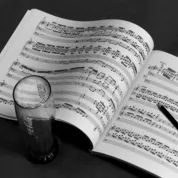
When it comes to playing a musical instrument, scales are foundational. While rhythm guitarists can rely primarily on chords, for the bassist and lead guitarist, scales are the musical alphabet from which grooves and harmonies are constructed. As the building blocks of music, they not only shape the melodic and harmonic basis of a song, but also serve as a guide for musicians in their improvisation and solos. This is especially true for bass players, whose role often involves bridging the rhythm and melody by creating a backbone for the song.
If you're a bass player who's recently started playing, a seasoned bassist looking to expand your musical palette, or just stuck in a creative rut, this article is a must-read! We're going to introduce you to 10 bass guitar scales that the pros use, walk you through the notes that comprise them, and teach you when and how to use them properly. Starting with the basic foundational scales, and getting more complex as the article progresses, this article has something in it for everyone.
A Brief History of Musical Scales
Triads on Bass
Our journey into the world of bass guitar scales begins with the simple and fundamental concept of triads, and will progress to more complex patterns. While triads aren't scales in a strict sense, they are the foundation of most scales and chords, including every scale mentioned in this article. Because of this, they serve as an important precursors to understanding scales.
These basic musical structures are the foundation upon which bass lines, riffs and solos are created, and often called the building blocks of harmony and melody. And while they are simple and easy to learn, some of the most memorable bass lines ever recorded use nothing but triads, such as "Another One Bites the Dust" by Queen, or "Billie Jean" by Michael Jackson.
How to Play Triads on Bass
In essence, a triad is a set of three notes that exist in nearly every scale. These notes can be stacked in thirds: the 1st, 3rd and 5th notes of the natural scale. Let's consider the key of C, which will be the reference point for this article. In this key, a C Major triad consists of the root (1st), major 3rd, and perfect 5th of the C Major scale. In terms of notes, this translates to:
C Major Triad:
- C (Root)
- E (Major 3rd)
- G (Perfect 5th)
Remember these notes and their 1st, 3rd and 5th positions, as they will reappear multiple times throughout this article.
The C Minor triad, on the other hand, comprises the root, minor 3rd, and perfect 5th of the C Minor scale, which translates to:
C Minor Triad:
- C (Root)
- Eb (Minor 3rd)
- G (Perfect 5th)
Experiment playing these notes on your instrument. You'll notice the Major triad produces a happy or bright sound, while the Minor triad offers a darker, sadder tonality. This difference is accomplished simply by changing one note (the E to Eb). By learning and practicing these two triadic structures, you're already on your way to creating richer, more engaging bass lines. Make sure to practice them in different keys at different positions on the neck. Some common key tonalities are:
- G Major Triad: G - B - D
- D Major Triad: D - F# - A
- A Minor Triad: A - C - E
- E Minor Triad: E - G - B
Remember, though they may seem simple, triads are essential building blocks in music. They offer a solid basis for understanding harmony, forming a springboard from which you can dive into the deep pool of more complex musical patterns. Take the time to get familiar with them, and you'll be rewarded as you progress further in your musical journey.
The Major Scales

1. The Diatonic Major Scale
The Major Scale is a natural extension of the Major Triad that we just discussed. As we move from the basic triad (C-E-G) to the full Major Scale, we incorporate four additional notes to complete this seven-note scale.
This scale is the cornerstone of Western music. It originated from the diatonic scale of ancient Greek music and has been used for centuries across a vast array of musical genres. The Major Scale is essential for understanding harmony, melody, chord progression, and musical composition.
How to Play the Major Scale
In the key of C, the Major Scale consists of:
- C (Root)
- D (Major 2nd)
- E (Major 3rd)
- F (Perfect 4th)
- G (Perfect 5th)
- A (Major 6th)
- B (Major 7th)
As you can see, the notes from the C Major Triad are positioned in the 1st, 3rd, and 5th positions of the C Major Scale. This will be the case with nearly every scale you'll learn. The triad forms the foundation of the scale, keeping the pattern in key. The additional notes in the 2nd, 4th, 6th and 7th positions, are what creates the scale's variance, and will be different depending on which scale you're playing.
When practicing this scale, begin at the root note C and move up through the notes until you reach the next C, one octave higher. Your left hand should remain in one position on the neck, moving up to higher strings for higher notes. On the A string play: C (middle finger) D (pinky finger), then on the D string play: E (first finger) F (middle finger) G (pinky finger), and last on the G string play: A (first finger) B (ring finger) C (pinky finger). Then, descend back down the scale by repeating this in reverse order.
Practice this numerous times until your fingers can play it without thinking. Then use a chart like this one on bassguitarscales.com to learn it in every position on the neck. This will strengthen your ear’s recognition of the Major Scale sound, and help your fingers become familiar with the pattern, so you can play it anywhere on the neck, from any octave.
The Major Scale is crucial to know, but it's important to note that musicians seldom play this pattern exactly as is in real-world scenarios. The beauty and expressiveness of music often come from the variations and departures from this foundational scale. Over the next sections, we'll dive into these variations, exploring how the manipulation of this fundamental scale can lead to truly captivating bass lines and solos.
2. The Major Pentatonic Scale
The Major Pentatonic Scale, a stripped-down version of the Major Scale, offers a different flavor and simplicity that can prove incredibly effective in creating melodically pleasing bass lines and solos. This five-note scale is essentially the diatonic scale we just discussed, minus the 4th and 7th degrees. We've removed two notes from it, resulting in a pattern that sounds more melodious and fluid, particularly when used in improvisation. And actually, if someone asked you to improvise a solo in C Major, you could simply move around the notes in this scale and get away with a pretty pleasant sounding bass solo.
How to Play the Pentatonic Scale
In the key of C, the Major Pentatonic Scale comprises:
- C (Root)
- D (Major 2nd)
- E (Major 3rd)
- G (Perfect 5th)
- A (Major 6th)
To practice this scale, start on the root note C, and ascend through the notes until you reach the next C, similar to how we outlined in the previous section. Then, descend back down to your starting note. This will familiarize your fingers with the pattern and your ear with the melodic structure of the Major Pentatonic Scale.
When it comes to creating captivating bass lines and solos, the Major Pentatonic Scale can be a powerful tool. It's often more melodic and versatile than a straight Major Scale, offering a more natural framework for improvisation. The simplified structure encourages smooth movement around the fretboard, making it an excellent choice for bassists aiming to elevate their musical expression. As we proceed, you'll see how these variations on the Major Scale can truly enrich your bass playing.
The Minor Scales

3. The Diatonic Minor Scale
Moving away from the happy-go-lucky major key, we now step into the more sonically rich, emotionally provocative Minor Scale. Originating from the ancient modes, the Natural Minor Scale is also known as the Aeolian mode. It has held a central place in Western music for centuries, and is where many rock and funk bassists start to have a lot of fun! Often described as having a 'sadder' or 'darker' tone than its major counterpart, the Minor Scale provides a compelling contrast to broaden our musical palette.
The Minor Scale's distinctive tone largely comes from the minor third, which introduces a sound of dissonance. This, in part, explains why the Minor Scale is frequently favored in genres that are known for being emotionally sad or aggressive, such as blues or rock.
How to Play the Minor Scale
In the key of C, the Natural Minor Scale consists of:
- C (Root)
- D (Major 2nd)
- Eb (Minor 3rd)
- F (Perfect 4th)
- G (Perfect 5th)
- Ab (Minor 6th)
- Bb (Minor 7th)
To practice, start at the root note C, ascend to the next C, and then descend back down, just as we've done in the prior sections. Familiarize you with the scale's unique tonal character and physical pattern on the bass.
4. The Minor Pentatonic Scale
Simplifying the Natural Minor Scale leads us to the five-note Minor Pentatonic Scale. Removing the 2nd and 6th degrees of the minor scale streamlines the structure, resulting in a pattern that's highly effective in creating memorable, fluid bass lines and solos.
This scale is a cornerstone of many music genres, particularly blues and rock, due to its melodic potency and the ease with which it can be used in improvisation.
How to Play the Minor Pentatonic Scale
In the key of C, the Minor Pentatonic Scale is:
- C (Root)
- Eb (Minor 3rd)
- F (Perfect 4th)
- G (Perfect 5th)
- Bb (Minor 7th)
The D (Major 2nd) and Ab (Minor 6th) from the Natural Minor Scale are omitted in this pentatonic version.
Practice this just as you did the C Major, C Major Pentatonic, and C Minor scales.
When to Play Major or Minor Pentatonic
Recognizing when to utilize the Major or Minor Pentatonic scales can greatly elevate your bass playing and musical understanding. Essentially, your choice will be guided by the key and tonality of the piece you're playing.
If the song or section of music is in a major key or exhibits a bright, happy, or triumphant mood, the Major Pentatonic Scale will often be your go-to. It complements the major tonality and aids in enhancing the piece's overall mood.
Conversely, if the music is in a minor key or conveys a sadder, darker, or more contemplative mood, you'll find the Minor Pentatonic Scale fits like a glove. Its tones resonate with the minor tonality, adding depth and emotional complexity. Artists such as Jimi Hendrix often incorporated this scale, with dramatic effect.
The beauty of music lies in its fluidity and the space it provides for creative expression. Don't be afraid to experiment! The 'rules' are guidelines more than rigid structures. For example, it's not uncommon for blues players to interchange these scales even within the same song or solo. Practice discerning the song's key and mood, experiment with both scales, and listen closely to the unique flavors they bring.
5. The Blues Scale
As we shift from our exploration of fundamental scales, we now enter into the exciting territory of scale variations. The following three sections will delve into variations of the minor scale, which provide the means to significantly enhance your bass lines. Mastering these minor scale modifications is a key step in advancing from a beginner to a pro-level bassist.
What Is the Blues Scale
First on our list is the Blues Scale, a seemingly simple variation that packs a punch. It's essentially the Minor Pentatonic Scale with an added diminished 5th, known as the 'Blue Note.' This added note injects a distinct 'bluesy' flavor into the scale, offering a touch of tension that can add intrigue to your bass lines.
The Blues Scale's roots lie in African-American communities, where it became a defining element of blues music. Since then, it's found its way into various genres, including rock, jazz, and heavy metal. Its versatility and emotional depth make it an invaluable tool for any bassist.
How to Play the Blues Scale
In the key of C, the Blues Scale consists of:
- C (Root)
- Eb (Minor 3rd)
- F (Perfect 4th)
- Gb (Diminished 5th, the 'Blue Note')
- G (Perfect 5th)
- Bb (Minor 7th)
Practice the blues scale between octaves as we did in the prior scales, but take some time to improvise a little with this one. Throw in the Gb 'Blue Note' to accent interesting parts of your bass line, creating tension, and observe how that note influences the overall feel of the bass line. One note can be a powerful thing!
6. The Harmonic Minor Scale
Next in our exploration of minor scale variations, we encounter the intriguing Harmonic Minor Scale. A close sibling of the Natural Minor Scale, this pattern diverges by incorporating a major 7th instead of the flat 7th. This single note alteration generates a distinctive tonal shift, lending a slightly exotic and 'Eastern' flavor to the scale.
The Harmonic Minor Scale has found its place in various musical genres, from classical compositions to jazz, metal, and even flamenco music. Its dramatic sound imbues a composition with a rich sense of drama and tension, making it ideal for use in emotionally charged or intense musical contexts.
How to Play the Harmonic Minor Scale
In the key of C, the Harmonic Minor Scale is:
- C (Root)
- D (Major 2nd)
- Eb (Minor 3rd)
- F (Perfect 4th)
- G (Perfect 5th)
- Ab (Minor 6th)
- B (Major 7th)
Note the impact of the Major 7th, which introduces a unique tonal flavor to the scale, opening up new possibilities for your bass lines.
7. The Melodic Minor Scale
Our final minor scale variation is the Melodic Minor Scale, a scale unique for its ascending and descending form. However, in modern music, particularly in jazz and fusion, it's common to use the ascending form in both directions. This scale can be thought of as a Harmonic Minor Scale with a major 6th added.
The Melodic Minor Scale is often used in jazz and fusion for its sophisticated, harmonically rich sound. It's a perfect choice when you want to add a smooth, jazzy flavor to your bass lines.
How to Play the Melodic Minor Scale
In the key of C, the Melodic Minor Scale is:
- C (Root)
- D (Major 2nd)
- Eb (Minor 3rd)
- F (Perfect 4th)
- G (Perfect 5th)
- A (Major 6th)
- B (Major 7th)
Pay close attention to the Major 6th and Major 7th, which lend the Melodic Minor Scale its unique, complex character. With practice, you'll learn to weave these minor scale variations into your bass lines, enriching your musical expression.
8. The Whole Tone Scale
We now step into the realm of the more complex and distinctive bass patterns. The Whole Tone Scale, while perhaps less familiar to some, is a powerful tool in your bass-playing arsenal that can offer an exotic and unusual flavor to your musical expressions.
The Whole Tone Scale is an intriguing scale that contains six notes, each separated by a whole step (as its name suggests). This scale is symmetrical, meaning that it maintains a constant intervallic pattern throughout. This unique structure imparts a certain 'dreamlike' or 'otherworldly' quality to the scale, often associated with an ambiguous or unresolved tonal center.
Famous composers such as Claude Debussy often used this scale to create a sense of the ethereal or fantastical in their compositions. In more modern contexts, it's frequently found in jazz, fusion, and used by experimental rock guitarists, such as the bestselling instrumental rock guitarist of all time, Joe Satriani.
How to Play the Whole Tone Scale
In the key of C, the Whole Tone Scale is:
- C (Root)
- D (Major 2nd)
- E (Major 3rd)
- F# (Augmented 4th)
- G# (Augmented 5th)
- Bb (Minor 7th)
As you practice this scale, pay attention to the lack of half-steps and how this impacts the overall 'feel' of the scale. Playing only whole steps can also make it difficult to find a comfortable fingering, especially for smaller fingers that have trouble reaching across frets, so be patient.
While it's perhaps less commonly used than some of the previous scales we've discussed, the Whole Tone Scale can add an unexpected and refreshing twist to your bass lines when used creatively and appropriately.
The Diminished Scales
Finally, we reach the most complex and fascinating pattern in our list: The Diminished Scale. With its unique structure and dissonant, tension-filled sound, the Diminished Scale can add an unmistakable touch of intrigue and complexity to your bass lines.
The Diminished Scale comes in two variations: The Half-Step/Whole-Step and the Whole-Step/Half-Step. Which is nothing more then alternating between whole steps and half steps. For the Half/Whole pattern, you play a half step, then a whole step, then a half step, then a whole step, etc. For the Whole/Half pattern you do the opposite: a whole step, half step, whole step, half step, etc. This pattern tends to be far easier to conceptualize and visualize in your head, then it is for your fingers to follow on the fretboard.
Bass players often gravitate towards one or the other, as switching between the two variations can be mentally challenging. Both variants are used frequently in jazz for their harmonic richness and dissonance, creating tension that can be resolved in many different ways.
9. The Half-Step/Whole-Step Diminished Scale
Half-Whole Diminished Scale in the key of C:
- C (Root)
- Db (Minor 2nd)
- Eb (Minor 3rd)
- E (Major 3rd)
- F# (Augmented 4th)
- G (Perfect 5th)
- A (Major 6th)
- Bb (Minor 7th)
10. The Whole-Step/Half-Step Diminished Scale
Whole-Half Diminished Scale in the key of C:
- C (Root)
- D (Major 2nd)
- Eb (Minor 3rd)
- F (Perfect 4th)
- Gb (Diminished 5th)
- Ab (Minor 6th)
- A (Major 6th)
- B (Major 7th)
Practicing each variant is key to understanding their distinctive sounds and where they fit best in your music. Artists such as Jaco Pastorius and Victor Wooten have utilized these scales to create strikingly intricate bass lines. In your own practice, experiment with these scales over dominant chords or in a blues context for an adventurous departure from more common scale choices.
Final Thoughts
The power to create mind-blowing bass lines is quite literally at your fingertips, waiting to be unlocked by understanding and practicing these scales. You'd be surprised how much you can accomplish by just becoming proficient in one or two of these. Play around with each of them, until you find one that works well with the genre and style you typically play. Then hammer away at it often, and in different situations. Once a scale starts to feel second nature, learn a new one and start experimenting with it.

Whether your goal is to jam with friends, join a band, or make lucrative career out of music, these scales are the stepping stones to get you there. With judicious use of these scales, you'll be able to take your bass lines from just average, to a truly pro-level sound that will make heads turn.
So, keep learning and keep practicing! We are committed at Band Pioneer to empowering musicians like you with valuable content for your continuous growth. If you're interested in improving as a musician or band, or turning your love for music into a profitable venture, make sure to explore more of our articles and resources. And let us know if there's anything you're looking for that we haven't covered already. Be curious, be persistent, and, above all, keep the groove alive!







Leave a Reply!
This is great video tutorials
I want to see tabs of those Larry Graham bass lines :D
This is great! I've always relied on video tutorials, but having the notes spelled out like this is perfect. TY so much!